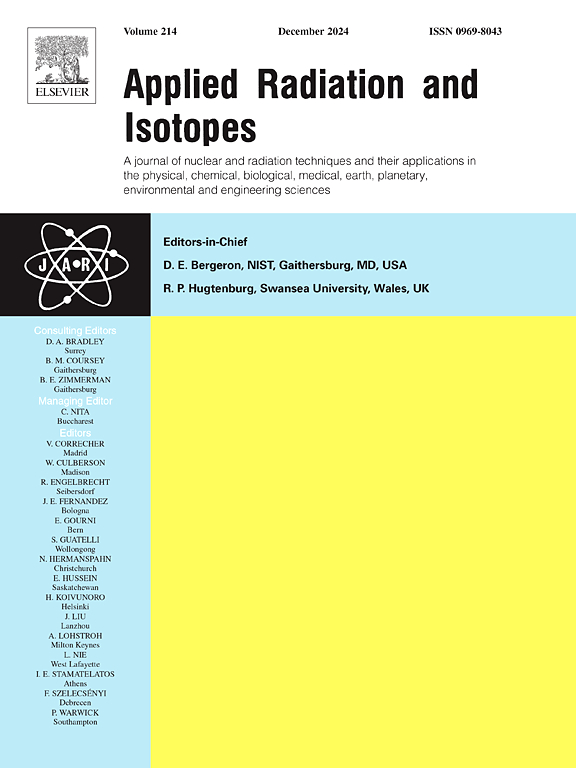Disinfection of fungus using X-ray irradiation for the preservation of contaminated organic artifacts of traditional heritage
IF 1.6
3区 工程技术
Q3 CHEMISTRY, INORGANIC & NUCLEAR
引用次数: 0
Abstract
In disaster situations such as tsunamis, floods, and typhoons, fungal contamination can significantly intensify within 48 h of submersion, rapidly spreading and damaging the value and structural integrity of organic cultural heritage artifacts. Consequently, the application of radiation-based disinfection has been increasingly studied as an effective method for prompt and reliable treatment. In most cases, the fungal species were successfully eradicated at a radiation dose of 5 kGy (gamma rays). Nevertheless, certain fungal strains demonstrated high resistance and survived even at doses ranging from 10 to 15 kGy, making disinfection more challenging. Notably, differences in threshold disinfection doses between gamma rays and electron beams (E-beams) have been reported. Therefore, this study investigated the threshold dose of X-ray radiation required to disinfect representative fungi that damage organic cultural heritage artifacts, including Epicoccum nigrum (high radiation resistance), Cladosporium cladosporioides (moderate resistance), and Aspergillus niger (common resistance). E. nigrum was effectively controlled at a dose of 12.5 kGy, while C. cladosporioides was controlled at 7.5 kGy and A. niger was controlled within the 5 kGy range. The results of this study suggest that at least 12.5 kGy of X-ray radiation should be used to preserve waterlogged traditional Korean art pieces after flooding or other water disasters.
利用x射线照射消毒真菌以保存受污染的传统文物有机文物
在海啸、洪水和台风等灾害情况下,真菌污染会在淹没后48小时内显著加剧,迅速蔓延并破坏有机文化遗产的价值和结构完整性。因此,作为一种及时可靠的有效治疗方法,辐射消毒的应用已得到越来越多的研究。在大多数情况下,真菌物种在5千戈瑞(伽马射线)的辐射剂量下被成功根除。然而,某些真菌菌株表现出高耐药性,即使在10至15千吉的剂量范围内也能存活,这使得消毒更具挑战性。值得注意的是,已经报道了伽马射线和电子束(e -beam)之间的阈值消毒剂量差异。因此,本研究调查了破坏有机文物文物的代表性真菌消毒所需的x射线阈值剂量,包括Epicoccum nigrum(高耐辐射)、Cladosporium cladosporioides(中等耐辐射)和Aspergillus niger(普通耐辐射)。12.5 kGy剂量可有效控制黑僵菌,7.5 kGy剂量可有效控制枝孢子线虫,5 kGy剂量可有效控制黑僵菌。本次研究结果表明,在洪水或其他水害发生后,要保护被水浸透的韩国传统艺术品,至少需要12.5 kGy的x射线辐射。
本文章由计算机程序翻译,如有差异,请以英文原文为准。
求助全文
约1分钟内获得全文
求助全文
来源期刊

Applied Radiation and Isotopes
工程技术-核科学技术
CiteScore
3.00
自引率
12.50%
发文量
406
审稿时长
13.5 months
期刊介绍:
Applied Radiation and Isotopes provides a high quality medium for the publication of substantial, original and scientific and technological papers on the development and peaceful application of nuclear, radiation and radionuclide techniques in chemistry, physics, biochemistry, biology, medicine, security, engineering and in the earth, planetary and environmental sciences, all including dosimetry. Nuclear techniques are defined in the broadest sense and both experimental and theoretical papers are welcome. They include the development and use of α- and β-particles, X-rays and γ-rays, neutrons and other nuclear particles and radiations from all sources, including radionuclides, synchrotron sources, cyclotrons and reactors and from the natural environment.
The journal aims to publish papers with significance to an international audience, containing substantial novelty and scientific impact. The Editors reserve the rights to reject, with or without external review, papers that do not meet these criteria.
Papers dealing with radiation processing, i.e., where radiation is used to bring about a biological, chemical or physical change in a material, should be directed to our sister journal Radiation Physics and Chemistry.
 求助内容:
求助内容: 应助结果提醒方式:
应助结果提醒方式:


